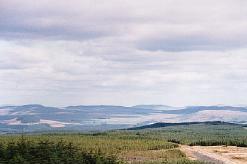Location and Access
![]() This is one of 2 way marked walks provided by Forest Enterprise in the Carrick Forest region of the Galloway Forest Park (although we are still inside Ayrshire!) in the Southern Uplands. Both start from the forest car park (NX 98 958) at 60m altitude near Stinchar Bridge on the unclassified road from Straiton to Newton Stewart. From the A77 south of Ayr, follow B7045 to the SE through Kirkmichael to Straiton and continue onwards through the village up into the hills for a further 10km. At Stinchar Bridge go left. The car park is high on the left.
This is one of 2 way marked walks provided by Forest Enterprise in the Carrick Forest region of the Galloway Forest Park (although we are still inside Ayrshire!) in the Southern Uplands. Both start from the forest car park (NX 98 958) at 60m altitude near Stinchar Bridge on the unclassified road from Straiton to Newton Stewart. From the A77 south of Ayr, follow B7045 to the SE through Kirkmichael to Straiton and continue onwards through the village up into the hills for a further 10km. At Stinchar Bridge go left. The car park is high on the left.
 The Cornish Hill Walk is the more interesting ornithologically of the two and as a walk. Though only 5km long, it entails a climb of 100m, quite steep and rough in places. Strong footwear is advisable.
The Cornish Hill Walk is the more interesting ornithologically of the two and as a walk. Though only 5km long, it entails a climb of 100m, quite steep and rough in places. Strong footwear is advisable.
![]() Off-road tracks unsuitable for wheelchair users.
Off-road tracks unsuitable for wheelchair users.
![]() On local byway network, linked to National Cycle Route 7.
On local byway network, linked to National Cycle Route 7.
The Walk
From the car park, which itself has magnificent views over Ayrshire, the route dips across the River Stinchar, here a sparkling burn close to its source, through a pleasant picnic area into young pine forest. The path is well defined but can be muddy. It climbs out of the forest within 1km onto rough moorland with heather and scattered rocky outcrops. The highest point, the summit of Cornish Hill, is at 467m and provides an impressive all round view of moors, lochs and far hills. A short, steep scramble down the far side towards the north end of Loch Cornish links up to the continuing trail which follows the infant Water of Girvan for 1km down a steep sided glen from its outlet from the loch. The path is well defined and the worst sections have board walks. Lower down, the route re-enters mixed and coniferous woodland and emerges on a sealed surface minor road which should be followed left back to the car park.
The Birds
Though the possible range is restricted, you can have interesting sightings in an exciting context. Out on the moor there are Red Grouse, Wheatear, Stonechat and Meadow Pipit for sure, and Buzzard, Kestrel and Raven. I have once seen a Merlin sitting tight and it is good Peregrine habitat. Black Grouse used to be common; there was once a lek site here. Common Sandpiper breed around Loch Cornish. The loch itself is quiet, though Goosander, Tufted Duck and Little Grebe are likely. Along the burns, expect to find Grey and Pied Wagtail and, possibly, Dipper. The woodlands do have Goldcrest, and the various tits, especially Coal Tit, and a few Treecreeper. Siskin, Linnet, Goldfinch, Greenfinch and Chaffinch are all present, taking a special interest in the picnic site. I have been treated to Crossbill in the CP on two occasions – once the male sat on the car mirror for some time, looking in! The ubiquitous Willow Warbler abounds in season. Of the thrushes, Song is quite common, though Mistle and Blackbird are present. Include Robin, Wren and Dunnock of course. I keep looking for Golden Eagle – the terrain is right.
Further Information
Beware: This is Adder country – another reason for wearing boots. You will be extremely lucky to see one, yet on one visit I came across a group of recently born young adders squirming across the heather, watched by a fond parent. The young are reputed to be particularly venomous.
Good mammal sightings may be had: I have seen Mountain Hare, Fox and Roe Deer on the open hill and Forest Enterprise sometimes holds Badger watches in the neighbourhood.
Each year, Forest Enterprise organises a range of activities in the Galloway Forest, including badger watches, and bat, barn owl and nightjar evenings. Details can be had from Tourist Offices or Forest Enterprise, Galloway Forest Office, Creebridge, Newton Stewart, DG8 6AJ (Phone: 01671 402 420). Try their web site.